 As a specialist in the relationship of the built environment to the well being of seniors, what trends are you seeing?
As a specialist in the relationship of the built environment to the well being of seniors, what trends are you seeing?
First, finally people across society are beginning to see the importance and impact of good design. More builders are reporting having clients asking for features that enable successful aging in place.
Second, consumers, professionals, and civic leaders are understanding that the built environment is a missing variable in health. There has been increasing research, emphasis, and awareness on the design of our communities with regards to walkability and access to fresh and healthy foods. My work takes this a step further, considering housing and zoning, as well as details like traffic light controls and crosswalk design. In particular, municipalities are increasingly evaluating and updating their policies for Accessory Dwelling Units (ADUs) to make it easier for a relative to move into a finished garage, basement, or addition, whether is be an aging parent or an adult child who is boomeranging back home.
Third, the growth of Age-Friendly Communities: Under AARP’s leadership, this World Health Organization initiative is currently assisting over 75 communities (and growing) in making policy, service, and infrastructure decisions which will enable their elders, and citizens across the lifespan, to thrive.

One service you provide relates to multigenerational community planning. Tell us more about the benefits and challenges of such communities. What are some examples of communities you’ve worked with?
A county I worked with in the Northwestern US is a Rural Retirement Destination, where the in-migration of older adults is over 15% annually. Persons 60 and older comprise about 17% of the population in rural communities, but in the various municipalities in this county, it is anywhere from 25 to over 50%. This is not only due to in-migration, but is also party due to the departure of younger adults and children, in large part due to a lack of affordable housing.
This situation is not unique to this community, nor to rural communities. These communities tend to have a large discrepancy between the financial resources of the full-time residents and the vacationers/seasonal residents. Often, there are only a handful of building contractors whose work is primarily large budget vacation homes. The communities are often rural, too, so a lack of infrastructure, services, and great distances can be a challenge to elders and to people of all ages.
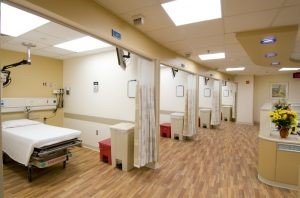
The first elder-focused ER at Holy Cross Hospital
My Enabling Design Approach considers and recommends:
1) Understand that the built environment impacts our behavior and functioning no matter how well or how poorly it is designed. We have the power to enable through good design. Communities need to examine their infrastructure (housing, transportation, streets, public spaces) to unlock its full potential to enable their citizenry.
2) Examine policies: Identify existing zoning policies—such as permits for ADUs (Accessory Dwelling Units, either attached or detached from the main dwelling), minimum square footage requirements, density—which are exacerbating problems, and develop new policies which enable solutions. One of my favorite policy solutions comes from New York City’s Age-Friendly pilot program: Older residents in an East Harlem neighborhood did not use the public pool because they were uncomfortable with the jumping and splashing children. So the pool developed Seniors Only hours several times a week.
3) Understand that meeting the needs of seniors is linked to meeting the needs of younger generations. One example is creating jobs for younger adults by expanding or creating services which meet the needs of the older population. This may also mean increasing public transportation options so that home health aides (who typically earn about $10/hour) can have a low-cost alternative to owning a car. This may mean having busses running more frequently, which could increase the availability of aides to people who only need services for short shifts, like four hours. These changes can have additional positive impacts, such as benefitting family caregivers, many of whom are women who are also working and raising children.
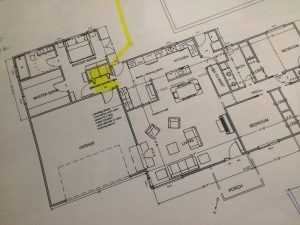
Another service you provide is around age-friendly housing design. For many of us who wish to plan ahead as we age, or who have elderly parents who many need to rethink their living situation, what advice do you have?
First and foremost understand that the built environment can either enable or disable based on the features. Most residential housing, whether new or old, is not designed considering people’s needs and abilities across the lifespan. One must realize that this is not rocket science. We’ve landed a satellite on a comet; we can remove basic barriers and enable independence! These features are important, but not complicated.
The key areas on which to focus are: Getting in and out of the home as well as being able to bathe, toilet, cook, and do basic self-care as independently as possible, for as long as possible.
Specific features include:
Zero-step thresholds: at the entry, throughout the house, and for the shower.
A full bathroom on the first floor, which does not need modifications as abilities change, or only needs minor additions (such as more grab bars). Make sure there is an extra outlet adjacent to the toilet for a bidet seat. It can allow for greater independence and minimize the need for caregiving.
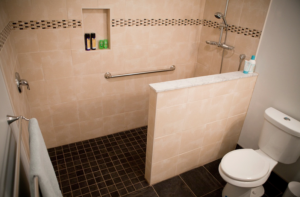
A universal bathroom
Lighting: Multiple options and light levels in each room. For example, in the kitchen, under-cabinet lighting provides higher levels of illumination for tasks. While indirect ceiling lighting provides general illumination. Look for easy to use controls, and consider remote controls or apps on tablets. It is crucial that lighting does not cause glare, often caused by poorly shielded or clear light bulbs.
Technology: I am very excited about the option of using apps to control lighting, heating, unlocking doors, etc., from a tablet. An application for remote operation of home automation can enable independent living. Using a tablet, one is able to adjust the size of the displays and controls. And tapping and swiping are often abilities that are retained when the abilities to grasp and turn are gone.
Plan for first floor living: People often assume that living on the ground level is necessary and preferred for independent functioning. A ground floor unit or ranch home is beneficial as everything is all on one level. However, there may still be issues of steps in and out of the home and doorways which are too narrow. You can live in a multilevel home if you plan for first floor living. Design a den or home office to double as a bedroom. Make sure that there is an adjacent accessible full bath. Having these options in your home allows anyone at any time who may have temporary or permanent difficulty with stairs to function as independently as possible on the first floor.
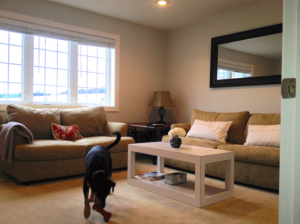
This den doubles as a first floor bedroom
Reach range: Design your home and arrange key items so that as many as possible are within the ideal reach range. For most people, this is between 18” and 44” off the floor. Consult with qualified professionals: Hire contractors and designers who have knowledge and experience with these types of projects, and ideally have credentials like NAHB’s Certified Aging in Place Specialist designation. To meet the needs of a loved one with more specific needs, involve an Occupational Therapist.
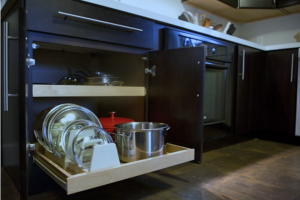
Pull-out trays make for easier access
What resources do you recommend to those concerned about housing as we age?
Laurie Orlov’s Age In Place Tech website
AARP Guide to Revitalizing Your Home: Beautiful Living for the Second Half of Life by Rosemary Bakker
Independent for Life: Homes and Neighborhoods for an Aging America by Cisneros et al. with the Stanford Center on Longevity
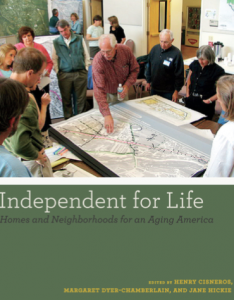
Contact Esther Greenhouse at esg@esthergreenhouse.com or 607-592-5433
Twitter: @EstherGreenhous
Esther Greenhouse is an environmental gerontologist—a specialist in the impact of the built environment on older adults. She is a nationally recognized expert on Universal Design and Aging in Place. A catalyst for change, Ms. Greenhouse applies the Enabling Design Paradigm in her work with communities as they evolve to meet the needs of both seniors and younger generations, resulting in successful age-friendly and multigenerational places. An award-winning and enthusiastic instructor and speaker, Esther advises clients to view the built environment as a missing variable in public health, infrastructure, and social services. This is the key to enabling greater independence and well-being. Esther served on the American Planning Association’s Aging in Community Policy Guide Task Force, co-authoring the Housing, Zoning, and Transportation sections, has written portions of the Livable NY Resource Manual, and teaches the NAHB/AARP Certified Aging in Place Specialist (CAPS) courses (for which she was awarded CAPS of the Year). Her innovative perspective has resulted in invitations to contribute to the book Independent for Life, the 4-part PBS series “Design for a Lifetime”, and the design of the nation’s first elder-focused emergency department.


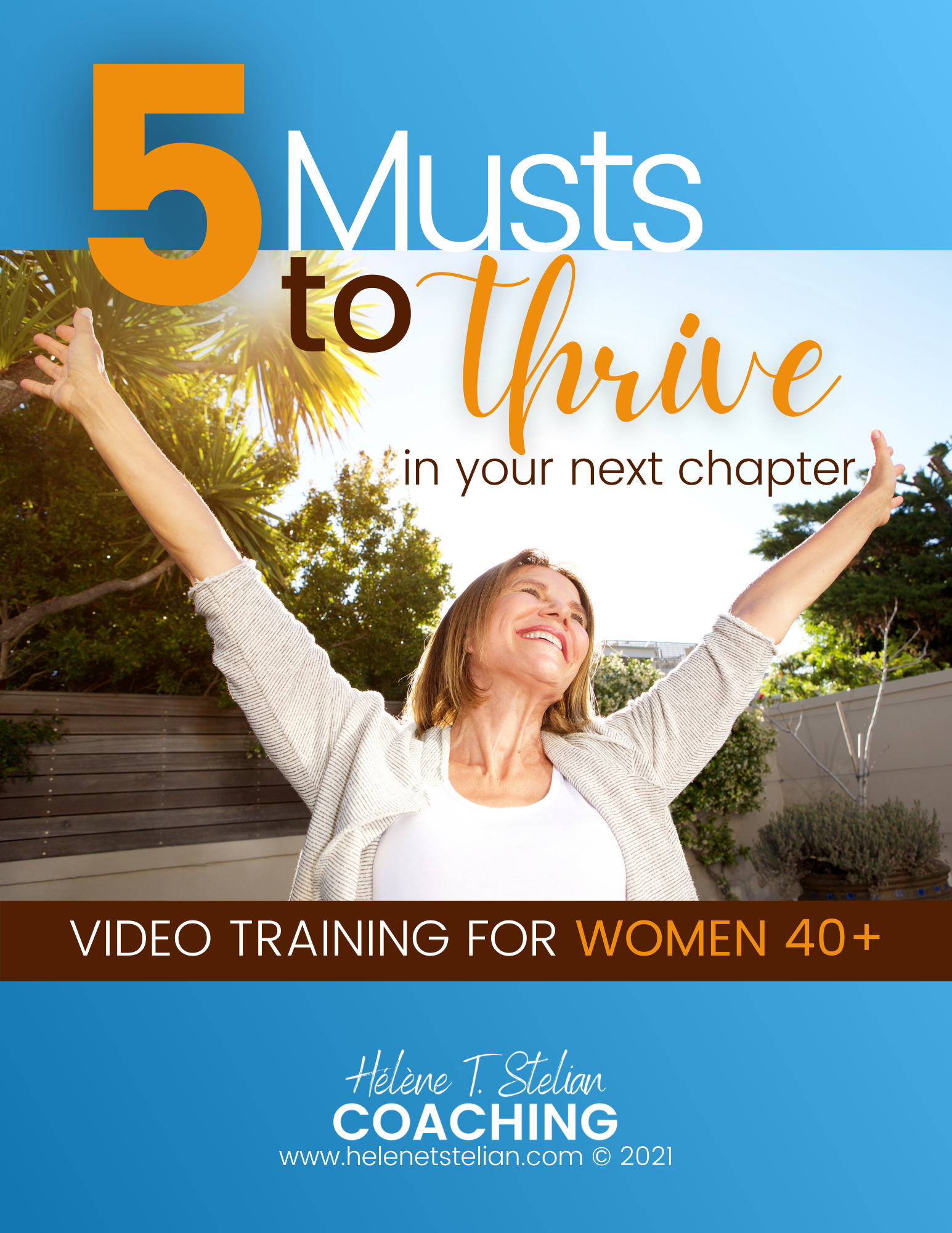



Esther offered here some cutting edge things to think about when doing any kind of remodeling for ourselves in our homes if we choose to age in them!
Thanks for checking this out Haralee!
This is fascinating, and so needed!
I agree, thanks for reading Tam!
My husband and I would like to age in place, but it is going to be difficult. Climate change has resulted in us being in a flood zone. The stairs from first to second floor are steep. Not sure, given the large percentage of aged residents of our county in upstate New York, that the resources even exist. But, if we do decide to remodel, we already plan to keep aging in place at the top of our priorities.
Sounds like you are on top of this and well aware of your options. Thanks for reading!
I’m so excited that there are people thinking and doing something about this. Got some great ideas in here on how we can help make mom’s summer home more age in place friendly.
Glad this was helpful to you Elizabeth!
Hi Hélène,
I really enjoyed reading your post and the images that you have used are too good. Like you list, I need to do this in my home. I think one of the hardest things to do is pull out mold, mildew and gunk from in between the tiles in the bathroom.
I really loved it, it’s so scary – every time you turn around it’s something new – toxins, poisons, dangerous toys, recalls, deadly cribs… it can be very overwhelming.
Thank you for an informative post that didn’t send me into full-scale panic.
Can you tell me the best way to increase internal environment of your home.
We need this now more than ever. We live in exciting times. Smart houses are slowly starting to sprout up, and before we know it, everyone has one. Do you think smart home assisted living will make aging in place easier?